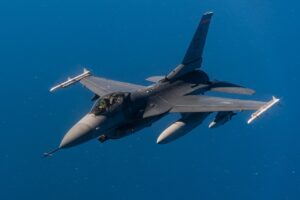A Pentagon spokesperson said Tuesday the department is prepared to potentially train Ukrainian pilots on F-16 fighter jets in the U.S “if capacity is reached in Europe.”
Air Force Brig. Gen. Patrick Ryder, the Pentagon press secretary, provided the update during a briefing while noting he did not have specifics to offer right now on where that training could occur.

“But, certainly, if the decision is made to do that and we move forward, we’ll be sure to provide you with updates on that,” Ryder told reporters.
The update arrives as Denmark has reportedly begun training the first eight Ukrainian pilots on Lockheed Martin [LMT]-built F-16s, with Greece also announcing plans to support the training effort.
Defense Secretary Lloyd Austin announced in late May that Denmark and the Netherlands would lead the effort to train Ukrainian pilots on F-16s to assist in its fight against Russia’s ongoing invasion, noting the U.S., Norway, Belgium, Portugal and Poland and others will also contribute to the initiative (Defense Daily, May 25).
Last week, the State Department confirmed the U.S. has given “formal assurances” to Denmark and the Netherlands that it will expedite requests for transferring F-16 fighter jets to Ukraine once pilot training is completed (Defense Daily, Aug. 18).
“We are very grateful to our European allies Denmark and the Netherlands, in particular, for leading this effort. And so, because this is a U.S. system there are certain laws and regulations in place in terms of how that equipment can be used by third parties. And so, as you recently saw, the State Department publicly announced our intent to support any requests so that’s part of the process. Again, we’ll have much more details to provide in the future as Denmark and the Netherlands kick off this program and we’ll be able to illuminate some of our additional support on that front,” Ryder said on Tuesday.
Army Gen. Mark Milley, chairman of the Joint Chiefs of Staff, told reporters in June it’s still “premature” to give a specific date on when advanced fighter aircraft could be employed in the fight against Russia’s invasion (Defense Daily, June 15).
“There’s a lot of work to do. You have to do language training. You have to do pilot training. You’ve got to get all the systems set in place. So those wheels are in motion, but we’re a ways from completion of that project,” Milley said at the time.